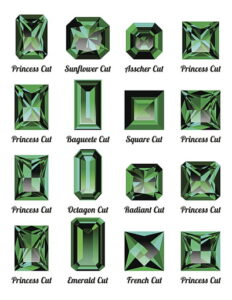
Emerald, a deep green rare gemstone that symbolizes peace and tranquility. Emeralds are loved for their color as they beautify your jewelry and according to legend, give you calmness and relax your nerves.
Buying an emerald is not as tricky as buying a diamond. Knowing the physical attributes of a gemstone can help you make the right choice. The 4C’s which are used to evaluate a diamond can also be used to choose the right emerald. However, a different significance is assigned to each C when assessing emeralds. By using the information about the 4C’s of emeralds, you can find a gemstone that is the right value for your money.
Color
Color is by far the most important C when evaluating an emerald. The best emeralds range from bluish green to pure green with bright tone and color saturation and which is not too dark, in contrast to diamonds where a colorless diamond is what brings in the most value. When you look at an emerald, it is either a bright vibrant green or a dull, limp color or possibly something in between.
Trace elements like chromium, vanadium and iron give color to an emerald. The presence or absence of each of these trace elements determines the exact color of the crystal.
The Three Color Categories of Emeralds
Hue
Hue means the type of green color an emerald has. Most emeralds sold in the market today range from bluish-green to dark green. If the color is too yellowish or bluish, it is not an emerald and the value will be lower compared to the original emerald.
The emerald market is saturated with Columbian emeralds and most of these crystals have a more intense pure green color. Whereas Zambian emeralds are said to have a cooler, more bluish-green color.
Tone
The tone determines its value. It classifies it in terms of light and dark. A good quality, naturally occurring emerald falls somewhere between very light and very dark.
It is believed that the darker the tone, the better the emerald. However, this is not true. An emerald with a medium tone is ideal for purchase, but it is important to look at the hue and saturation of the crystal as well.
Saturation
Saturation refers to the intensity and strength of the green color. Saturation can vary on a scale of dull to vivid. An emerald with dull saturation is likely to have more grey. Grey will reduce the saturation and give a dull look to the stone. Therefore, emeralds with visible grey should be avoided.
When you are evaluating the color of an emerald for your jewelry, make sure you go for a crystal that is greenish in color and has a medium tone and vivid saturation. You can fall in love with the green color with the right saturation and tone.
Clarity
Unlike diamonds where the value diminishes when there are inclusions, emeralds contain them and are visible to the eye without the aid of any equipment.
In fact, 99% of the naturally occurring emeralds have inclusions. The GIA organizes emeralds as Type 3 which means that there are always inclusions. If you don’t see any inclusion, you need to check if the emerald is real or not.
Inclusions are not necessarily bad for emeralds. Emeralds belong to the beryl mineral family and the inclusions are a result of liquids, gases and minerals like chromium and vanadium.
As with diamonds, emeralds with better clarity are sold at a higher price in the market. When the inclusion affects the transparency and clarity of the stone, it can dramatically reduce its value.
However, you need to be careful about the type of inclusions you see. Typical emerald inclusions resemble branches and roots. So if you see inclusions that look like bubbles and big blotches, the emerald is not for you.
Cut

Just like with diamonds, the cutter of an emerald must consider the depth of color, durability and inclusions when making the decisions about cutting the stone. Mistakes in cutting can seriously affect the value of this precious gem and can result in considerable weight loss.
Ideally, an emerald should be cut in a symmetrical manner so that the appropriate amount of light can pass through the stone. If cut too deeply, the light will escape on the side and the emerald will look dark. Similarly, if the cut is too shallow, the emerald will not appear brilliant. Since color is a very important consideration when choosing an emerald, the cut must maximize the hue, tone and saturation of the stone.
The three most popular cuts are Emerald, Asscher and Octagon, with the emerald cut the most desired. It is a rectangular or square cut that maximizes the shape of the rough and allows maximum light to flow in, giving the right brilliance and tone to the stone. Apart from the emerald cuts.
One important factor when cutting an emerald is that all of these stones have naturally occurring inclusions and fissures. A cutter must design the cut in a way that the finished stone has minimal impact on the clarity of the stone.
Carat Weight
The weight of emeralds is measured in Carats where each carat is equal to 0.02 grams. The emeralds with the Royal Family and in the museums weigh hundreds of carats and are extremely valuable. In comparison, the popular size of emeralds used in jewelry is between 0.25 and 1.5 carats.
An emerald with more carat weight will be more expensive compared to a smaller emerald keeping all other factors the same.
Choosing a rare gemstone can be tricky for an untrained person. With more information about the 4C’s of emeralds, you can surely make a more informed decision when choosing emeralds for your jewelry.
